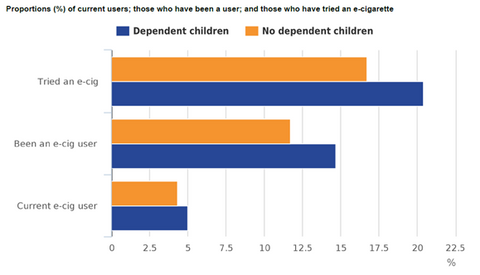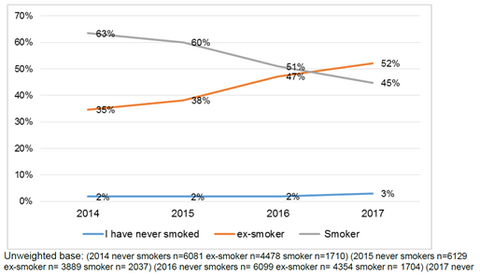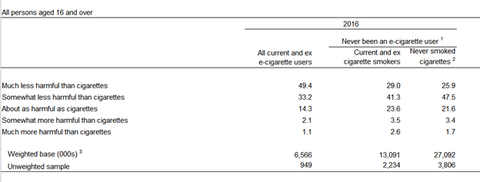It wasn’t too long ago when vaping became synonymous with health issues akin to smoking cigarettes. It was also believed to encourage smoking addiction, especially within the younger demographic.
Recent studies have, however, shed light on the misconceptions surrounding vaping. In this article, I want to take a close look at the current scientific evidence shattering the myth that there is any kind of equivalence between vaping and smoking.
1. Long-term side effects
Long-term studies of vaping are few and far in between, especially since e-cigarettes have only been introduced to the UK in 2007. Experts from the British government and research bodies both note the need for more research on the topic.
However, 2017 saw the first cross-sectional research that looked at the long-term side effects of e-cigs. Funded by the Cancer Research UK, the study found that e-cig users have substantially reduced levels of carcinogens and toxins in their bodies.
Vapers also reported fewer symptoms that are traditionally associated with smoking like coughing, irritability, and nausea.

They also experienced improved circulation and a better sense of taste and smell, compared to smokers.
2. Health risks
Since e-cigs first hit the global market, scientists have put to question the health risks that come with vaping. The World Health Organization even went as far as saying it’s not a legitimate way to quit smoking.
However, pretty much every peer-reviewed study has shown unequivocally that vaping comes with far fewer risks than that of smoking. Let’s examine this in more detail now.
- Cancer risk
A study published on the NCBI in 2017 compared the lifetime cancer potencies of vaping and smoking when users inhale aerosol emissions and combustible tobacco, respectively. Results revealed that the cancer risk that comes with vaping is less than 1% of that from smoking.
- Cardiovascular and lung disease
According to an updated evidence review by Public Health England (PHE), the risks of cardiovascular and lung disease for vapers have yet to be quantified. This, however, is more likely to be below that of those who smoke. In fact, acrolein content (a respiratory irritant) among vapers were found to be consistent with those of non-smokers.
PHE also found that certain flavours do not pose health risks, but noted that inhalation of some can be a source of preventable risks.
A separate study by the Cancer Research UK found that a chemical called NNAL, which is known to cause lung cancer, is 97% lower in vapers compared to smokers.
3. Less harmful than smoking
A study by the University of Birmingham found that exposure to vapour boosts production of inflammatory chemicals in the body, kills protective cells in the lungs, and decreases the body’s ability to engulf bacteria. However, study leader Professor David Thickett maintains that e-cigarettes are still less harmful than smoking and safer with regards to cancer risk.
PHE echoes this by saying that vaping only poses a small fraction of the risks that smoking does. Switching from smoking to vaping also comes with substantial health benefits, with the PHE research concluding that e-cigarettes are 95% safer than traditional cigarettes.
The important point here is that there is still work to be done to establish the health effects of long-term vaping but the evidence is crystal clear that compared to smoking cigarettes, vaping is significantly safer.
4. Risk to bystanders
PHE found no health risks associated with passive vaping to bystanders, as opposed to the various health risks of second-hand smoking. A 2015 survey by the Office of National Statistics (ONS), e-cigarettes do not have any impact on others who are exposed to vapour but do not use e-cigs.
5. Tobacco content
Inhaling burnt tobacco, as in the case of smoking, is what causes damages to human health. Vaping removes the tobacco element and its combustion, replacing it with nicotine instead, which then decreases its health risks.
In fact, a study from PHE revealed that tobacco levels in vapers were close to that of non-smokers. There are also early studies that showed e-liquids and their vapours do not contain the same level of toxic chemicals as that of cigarettes.
However, as pointed out above, this does not automatically mean that vaping is completely safe. There remain to be studies that suggest smoking e-cigs for 30 minutes can also stiffen arteries similar to smoking tobacco. This then calls for more research in long-term safety of e-cigs.
6. Vaping as a gateway to smoking
One of the reasons cited by various governments and organisations for banning the use of e-cigs is because it’s deemed to be the gateway to smoking addiction, especially in teenagers.
However, there have been no conclusive studies that prove causality. Indeed there are simply too many other factors that can contribute to teenagers picking up their smoking habits for this to ever be accurately ascertained.
In 2017, the International Journal of Environmental Research and Public Health published the largest study (to date) that looks into young people and vaping. With over 60,000 teenagers as respondents, research revealed that regular vaping by teens who have never smoked is only at less than 1%. On top of that, youth smoking rates in the UK continue to decline. If there is, indeed, causality between vaping and smoking, the number of teenage smokers should increase as vaping continues to grow in popularity.
PHE also found that experimentation occurs naturally among teenagers (as it always has) but e-cigarettes attract relatively few young people who have never smoked before.
7. Quitting smoking

Source: ASH
The top reason for e-cigarette use is to quit smoking, based on ONS data. In fact, 2017 numbers by Action on Smoking and Health (ASH) showed that there is a continued rise in ex-smokers who switched to e-cigarettes (52%), while current smokers who use e-cigs are on a decline.
As for current cigarette smokers, e-cigs are their way to cut back on tobacco intake but not to completely quit the habit.
Another study by Cancer Research UK found that nicotine levels in vapers were the same as those in smokers and those in need of nicotine replacement therapy (NRT). This means that vapers can satisfy their nicotine cravings even with e-cigarettes.
According to study leader Dr Lion Shahab, three decades into the research of NRT and they have yet to see any significant long-term health issues. This then suggests that e-cigarettes are relatively safe as well.
The Royal College of Physicians also published their own research, revealing that e-cigs are effective in aiding people to quit smoking and that the long-term hazards of inhaling vapour are unlikely to exceed 5% of the harm that tobacco smoking causes. They go further by recommending that GPs promote vaping as a substitute for smoking.
8. Perception of harm
Data from ONS revealed that e-cigarettes are perceived to be less harmful than cigarettes, be it a vaper who is an ex-smoker, a current smoker, or one who hasn’t used any e-cig.

Source: ONS
9.Response from various UK government bodies and organisations
All the new studies that recently came out had a huge hand in influencing UK policies.
For one, PHE and various public health organisations like the Cancer Research UK and ASH released a joint statement in 2016, relaying their broad consensus that e-cigarettes are a lot less harmful than smoking.
In 2017, the Royal College of General Practitioners (RCGP)issued a position statement that encourages clinicians to recommend vaping to patients who want to stop smoking. They also highlighted the fact that ongoing research is needed to further establish the safety of e-cigs and their contribution to smoking cessation.
The British Medical Association (BMA) also published their own position paper in support of e-cigarettes. Similar to the RCGP, the BMA also believes that using e-cigarettes is a positive choice for smokers who intend to quit. Vaping would also help the organisation’s goal in achieving a tobacco-free society.
Last year, PHE even included e-cigarettes for the first time in their annual Stoptober campaign.
Video:https://youtu.be/p2qmcE58oY0
Meanwhile, in Scotland, various organisations led by Health Scotland reached a consensus and issued a statement in support of vaping. Although the goal is to completely stop smoking, vaping remains to be an effective way to help smokers start quitting.
The British Heart Foundation, on the other hand, maintains that smokers with heart conditions will find it easier to quit when they use e-cigarettes. Although the organisation do not advise non-smokers to start using e-cigs, they do believe that it’s a useful tool to reduce harm and stop smoking.
10. Response from countries that previously banned vaping
Worldwide, there are still plenty of countries that continue to ban vaping use. For some, this could result in fines, while other governments punish this with imprisonment. But we are seeing a massive change in policies around the globe.
In New Zealand, for instance, their Ministry of Health started supporting vaping products in 2017, putting in place regulations similar to that in the UK.
Canada also started to legalise e-cigarette use, although regulations are still in the works.
Numbers Don’t Lie
Although vaping started with much controversy and opposition, these studies prove that there is a growing acceptance of e-cig use within the scientific community and various health sectors.
Today, the number of smokers in the UK dropped to 17.2%--a number that the country hasn’t reached since 1974 and is attributed to the rise in vaping. On top of that, more than a million people in Britain are now vaping to quit smoking. And these numbers continue to increase worldwide.
If you’re just starting out, be critical of the information you are getting. Make sure these come from reputable sources and are factual. Contact us via email at info@superiorvapour.com or call us on 01179 669309, if you need more information.




















